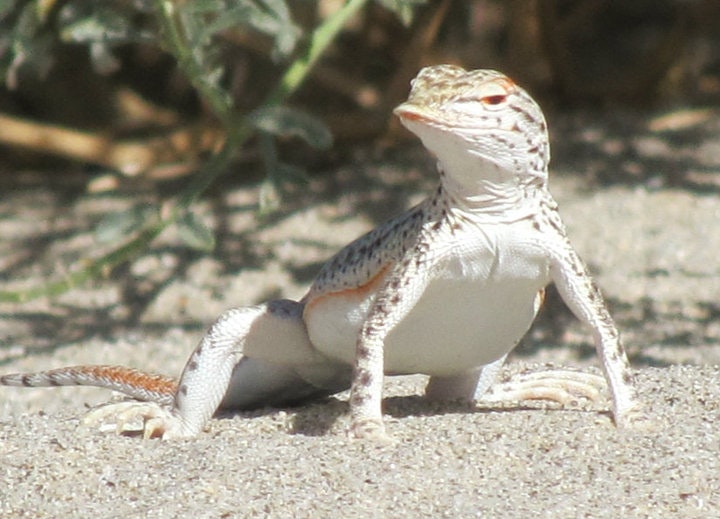Native Species

Southern California may invoke images of urbanization, but it is actually a treasure box of habitats and micro-climates. This diversity allows for a cornucopia of native species to exist in even the most developed pockets of landscape. Native species are organisms that exist in an area for natural reasons such as evolution. They have evolved with that particular environment and have a set of adaptations specific to survival in that ecosystem. There are two types of native species: indigenous and endemic. Indigenous species are found naturally in multiple places as where endemic species are found in one specific area only. For example, the Virginia Opossum is naturally found in many California habitats but it can also be found throughout most of North America, therefore it is an indigenous species. In contrast, the Coachella Valley Fringe-toed Lizard is only found in specific sand dunes in the desert region of Riverside County, this is an endemic species. Indigenous wildlife tends to be more robust and resilient to changes to their habitat. Endemic species tend to be more fragile because of their specific habitat requirements and adaptations. Even slight changes in their environment can have devastating consequences. Whether a native species is endemic or indigenous, their resource requirements must be taken into consideration as Southern California continues to expand and demand more of our natural resources.
Multiple Species Habitat Conservation Plan (MSHCP)
The Western Riverside County Multi Species Habitat Conservation Plan (MSHCP) is a unified plan that guides development and provides for economic growth while protecting local habitats for native plants and animals. In the 1980s-1990s a growing number of endangered species was slowing urbanization. Through a lengthy stakeholder process and environmental evaluation, a comprehensive approach was developed to protect our unique landscapes and wildlife while expediting development. The Western Riverside County Regional Conservation Authority (RCA) was created to steward the Plan, or MSHCP. The RCRCD was part of the process that developed the plan. The RCRCD conducts habitat conservation projects that support and complement the Plan and staff work with RCA in the sharing of information.
Threatened or Endangered

In 1973 the United States government passed the Endangered Species Act. The purpose of this legislation is to prevent the extinction of fragile species and is considered one of the best tools the nation has for combating extinctions. In fact, according to the World Wildlife Fund, 99% of all species protected under the act have avoided extinction. Under the act, declining plants and animals can be listed as either threatened or endangered. A threatened species is a species that is likely to become extinct in a considerable portion of its range. An endangered species is a species that is on the edge of extinction throughout its range. Individuals and organizations can petition to have a species listed but petitions undergo rigorous review. Once listed, federal, state, tribal and local entities coordinate to protect critical habitat and create recovery plans. Listed species are continuously monitored to determine whether the species is recovering. An endangered species can be on its way to recovery and be downgraded to threatened status. Once a species is considered recovered, it is removed from the Endangered Species List.
Below are the current federal and state listing status of several species that fall within the Riverside-Corona Resource Conservation District:
Fish/Crustaceans
Santa Ana Sucker (Catostomus santaanae) [FT]
Riverside Fairy Shrimp (Streptocephalus woontoni) [FE]
Amphibians
Arroyo Toad (Anaxyrus californicus) [FE]
Western spadefoot (Spea hammondii) [UR]
Birds
Coastal California Gnatcatcher (Polioptila californica californica) [FT]
California Spotted Owl (Strix occidentalis occidentalis) [UR]
Least Bell’s Vireo (Vireo bellii pusillus) [FE, SE]
Western Snowy Plover (Charadrius nivosus nivosus) [FT]
Southwestern Willow Flycatcher (Empidonax traillii extimus) [FE, SE]
Tricolored blackbird (Agelaius tricolor) [ST]
Western Yellow-Billed Cuckoo (Coccyzus americanus occidentalis) [FT, SE]
Mammals
Stephen’s Kangaroo Rat (Dipodymus stephensi) [FE, SE]
San Bernardino Kangaroo Rat (Dipodomys merriami parvus) [FE]
Reptiles
Southern rubber boa (Charina bottae umbratica) [UR]
Insects
Quino Checkerspot Butterfly (Euphydryas editha quino) [FE]
Delhi Sands flower-loving fly (Rhaphiomidas terminatus abdominalis) [FE]
Code: F = Federal; S = State; T = Threatened; E = Endangered ur= Under review
